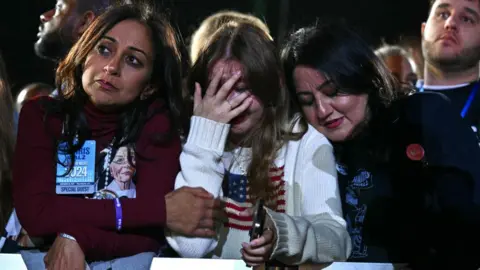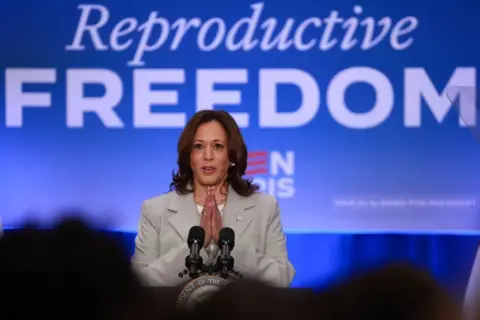 Getty Images
Getty ImagesLeading up to Election Day, at least one thing was taken for granted — women across America would vote for Kamala Harris.
Just as months of consistent polling have shown Harris in a near tie with Donald Trump, many of the same surveys tell the story of a growing gender gap.
That’s the strategy Harris’ team is betting on, hoping that women’s strong performance will make up for losses elsewhere.
It didn’t happen.
Nationally, a majority of women did vote for Harris, but not by the historic margin she needed. Conversely, if early exit polls confirm, Harris’ overall advantage among women — about 10 points — is actually 4 points lower than Joe Biden’s advantage in 2020.
Democrats lost 10 points among Latina women and made little progress at all among non-college-educated women, who once again supported Trump 63 to 35, Preliminary data suggest.
The deficiency is not due to lack of trying.
Throughout her 15-week campaign, much of Harris’ messaging has been directly aimed at women, most notably her emphasis on abortion.
Along the way, Harris made reproductive rights a cornerstone of her advocacy. She repeatedly reminded voters that Trump once boasted of his role in overturning Roe v. Wade, the ruling that ended abortion rights nationwide.
“I will fight to restore what Donald Trump and his hand-picked Supreme Court justices took away from the women of America,” Harris said in her closing remarks in Washington, D.C., last week.
Her most powerful ads feature women suffering from state abortion bans (what Harris considers the “Trump abortion bans”), including those who say they cannot access abortion care.
The strategy appears to exploit the enthusiasm for abortion that propelled Democrats to unexpected success in the 2022 midterm elections.
Abortion rights remain widely popular – A May Gallup poll showed Only 1 in 10 Americans think it should be banned.
Even these election results seem to underline this. Of the 10 states that voted on abortion, eight voted in favor of abortion rights.
But that support did not translate into support for Harris.
 Getty Images
Getty ImagesEvan Ross Smith, a pollster and campaign consultant, said abortion does matter to women, but not enough.
“The voters who have the strongest views on abortion, particularly women, are already voting for Democrats,” he said. But Democrats have been unable to elevate the importance of abortion to women who don’t yet see it as a pressing issue.
“The abortion argument simply doesn’t penetrate women without a college education and doesn’t move them an inch. They lose ground among Latinos,” Mr. Smith said.
For many, the decisive issue is economics.
Inflation and affordability remain the top concerns for voters in pre-election surveys and preliminary exit data. For these voters, Trump is the overwhelming favorite.
Jennifer Varvar, a 51-year-old independent from Grand Junction, Colorado, said she had not even considered voting for Harris because of the economic pressure she has faced over the past four years.
“For me and my family, our financial situation is worse than ever. It’s a struggle. I’m trying to put food on the table for my three boys,” she said. She said things were better under Trump and that’s why she voted for him.
 Getty Images
Getty ImagesBut some analysts said even if gender didn’t divide the electorate as some expected, it still played a role in Harris’ defeat.
Many explanations have been offered for Trump’s resounding victory, but for some, one thing stands out.
“I do think the country is still sexist and not ready for a female president,” said Patti Solis Doyle, who ran Hillary Clinton’s 2008 presidential campaign. Solis Doyle told Politico.
Unlike Clinton, who explicitly leaned into the potential of her gender and campaign history, Harris was clearly unwilling to do so.
It is widely believed that the United States is now more ready for a female president than it was when Clinton ran for the second time in 2016. But this remains an open question.
one Reuters/Ipsos October poll Shows that 15% of respondents could not vote for a female president.
Donald Trump, who doubled down on his masculinity this election, may have played a role in exploiting this.
Mr Smith said: “He positioned the president as a tough guy in a dangerous world… He described it as a job description.”
“In the view of many Americans, this is one of the most difficult job descriptions for women to successfully fill.”



